Warring States Period › Queen Seondeok » Ancient origins
Articles and Definitions › Contents
- Warring States Period › Ancient History
- Queen Seondeok › Who Was
Ancient civilizations › Historical and archaeological sites
Warring States Period › Ancient History
Definition and Origins
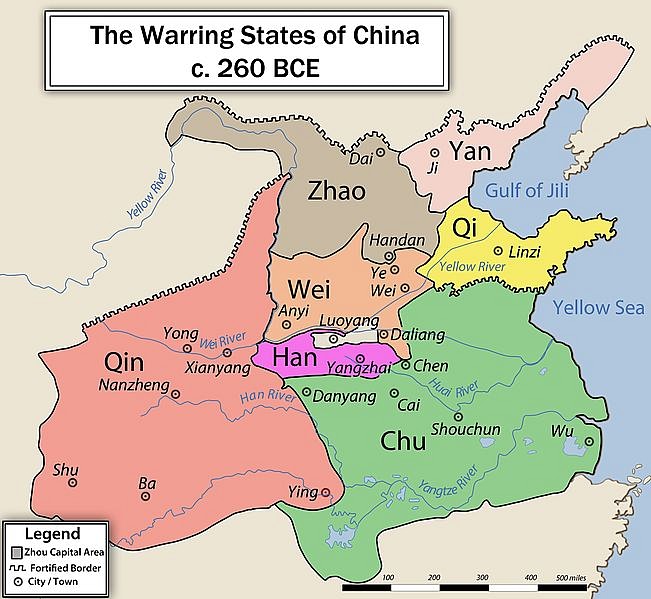
The Warring States period (481/403 BCE - 221 BCE) describes the three centuries when various rival Chinese states battled viciously for territorial advantage and dominance. Ultimately the Qin state was victorious and established the first unified Chinese state. Besides incessant warfare, and probably because of it, the period saw significant developments in society, commerce, agriculture, philosophy, and the arts, setting the foundations for the subsequent flourishing of Imperial China.
TIME FRAME
The time frame of the Warring States period ( Zhanguo ) is not agreed upon by all historians, with some preferring 481 BCE as the starting point when the Lu chronicles end and others plumbing for 403 BCE when the three states of Han, Wei, and Zhao were officially recognised by the Zhou court. Still others chose dates within that period, the most popular being that of the ancient Chinese historian Sima Qian : 475 BCE. The end date is usually defined as the establishment of the Qin Empire : 221 BCE. The period is covered by two ancient Chinese chronicles of uncertain date and unknown authors: Discourses of theStates and The Intrigues of the Warring States.
BACKGROUND
In the 5th century BCE the Eastern Zhou (Chou) Dynasty (771-256 BCE) was crumbling. No longer dominant in military terms, the Zhou were forced to rely on armies of other allied states, who on occasion took the opportunity to forward their own territorial claims. For this reason, the Zhou king was compelled to sometimes make the military leader of another state the military leader of the Zhou alliance. These commanders were given the honorary title of ba or Hegemon, although they and the leaders of other states in the alliance had to swear loyalty to the Zhou feudal system.
SEVEN MAJOR STATES VIED FOR CONTROL OF CHINA: THE CHU, HAN, QI, QIN, WEI, YAN, & ZHAO.
By the early 4th century BCE nearly 100 small states had been consolidated by conquest into seven major states: the Chu, Han, Qi, Qin, Wei, Yan, and Zhao. Sandwiched between these were several smaller states but the big seven had by now become so large and consolidated that it became difficult for one to absorb another. Further encouraging this segregation of territory was the trend of building long defensive walls along frontiers, some of which were several hundred kilometres long.Made of stone and earth, long sections still survive today including the Qi wall at Mulinngguan in Shandong province which is 4 metres high and 10 metres across in places.
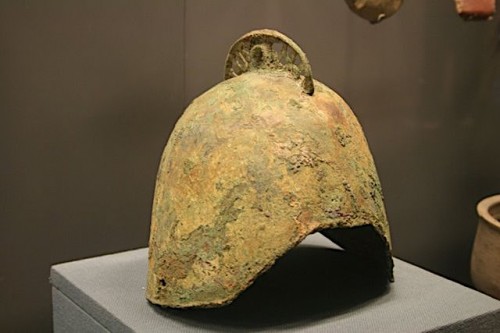
Warring States Helmet
In each state, the ruler declared himself king and independent of the Zhou empire. Each now looked to expand their territory at their neighbour's expense, often attacking rivals over succession disputes caused by the common policy of intermarriage between different royal families. Eventually, this rivalry led to ever-shifting alliances and the incessant conflicts that gave the period its name. Between 535 and 286 BCE there were 358 wars between states. Huge armies were led by commanders who abandoned the chivalrous etiquette of warfare in previous times (if, indeed, there had ever been such a thing) and ruthlessly campaigned to destroy the enemy - both soldiers and non-combatants. The prize for the victor would be control of a unified China.
A NEW TYPE OF WARFARE
Cavalry of mounted archers on sturdy Mongolian steeds, large infantry armies based on universal conscription, and the diffusion of new iron weapons such as swords and crossbows (which led to new armour), made warfare during the Warring States Period much more deadly than in previous eras. The slower and more organised battles of yesteryear where chariots were used in large numbers and infantry were deployed in a more predictable manner now gave way to a much more dynamic battlefield. Warfare also became more sophisticated with more subtle and disciplined troop deployments, subterfuge and espionage playing their part in victories.
Chivalry may or may not have gone out of the window but one thing that did certainly change was the scale of battles with armies frequently fielding over 200,000 infantry compared to the more usual 10,000 in earlier times. The Qin, Qi, and Chu states each possessed a total infantry force of close to one million men and a cavalry force of 10,000. Battles were no longer over and done with after a couple of days either but dragged on for months or even years with casualties in the tens of thousands. The armies of a particular state had to fight on multiple fronts, and the objective was now not only to gain new territory but to systematically destroy the military capacity of the enemy. The huge numbers involved meant that soldiers were relatively untrained and warfare became less a matter of fighting skill and more about having such a numerical supremacy that a commander could overwhelm his opponent in the field.
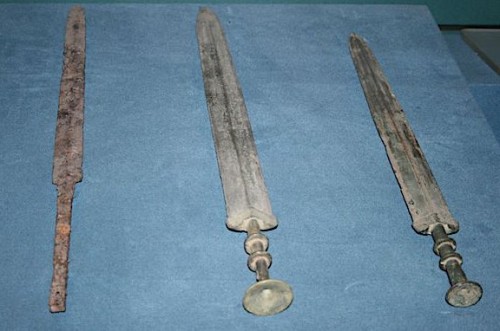
Warring States Period Swords
Such continuous warfare must have had a heavy toll on the ordinary populace. Apart from invasion and its consequent destruction of property and crops, males were expected to fight for the state. One of the last great battles of the period at Changping involved the Qin conscripting every male over 15 years of age, but this seems to have been unusual. Still, with so many wars it would have been difficult for a farmer to have avoided military service. There were rewards for soldiers who fought well, notably in the Qin state where a whole system of ranks and rewards was introduced with 20 different levels open to everyone. For example, cutting off a single enemy head entitled the soldier to move up the ranking ladder and acquire around 5 acres of land.
Success in war became the sole goal of the state and everyone in it, as the historian L. Feng here summarises:
During the Warring States period, warfare was the most important aspect of social life, the principle of the state, and the compass that directed government policies. It is no exaggeration that by the late Warring States period (3rd century BCE), war had escalated to the level that the entire state was organised for the very purpose of war, and this was true for all states (197).
Another development in general warfare was the expectation on the commanders. No longer enough to claim a right of command through birth, they now had to demonstrate the military skills which were expounded by the plethora of treatises which arrived on the subject such as Sun Tzu's Art of War. Strategy was important on the battlefield but it became essential in siege warfare when the enemy chose to try and resist attack from within their well-fortified cities or when they protected their borders with watchtowers connected by defensive walls.
THE RISE OF QIN
Rather ironically given future events, the Qin was one one of the few states which remained loyal to the Zhou. For example, the Qin ruler, Duke Xin, was rewarded for protecting Zhou interests with the title of Hegemon in 364 BCE. His successor Xiao, was given the same honour in 343 BCE. Xiao is known for taking on the services of the gifted advisor Shang Yang, poached from the Wei state, who then reorganised the Qin state and made it even more powerful. Populations were better censored and regions divided into more easily administered provinces and counties so that the collection of taxes (in the form of both goods and labour) was made more efficient. Such was the strength of the Qin now that the Zhou king awarded a royal status and insignia to the ruler Huiwen in 326 BCE.

Chariot, Terracotta Army
The Qin state had the advantages of a protective mountain range on its eastern border and was one of the peripheral states so that it had more freedom to expand into territory not held by a rival Chinese state. Now that they had both a strong and organised government based on the principles of Legalism, with its emphasis on laws and procedures (expounded by the ministers Lu Buwei and his protege Li Si), an expanded bureaucracy with local officials and magistrates to help run the provinces, and the economic wherewithal to field large, well-equipped armies, the Qin could begin to plan a more ambitious campaign of major conquest.
A GREAT QIN VICTORY WAS WON AGAINST THE ZHAO IN 260 BCE AFTER A THREE-YEAR BATTLE STRETCHED ACROSS A 160 KM FRONT.
The victory over the Shu state in 316 BCE allowed the Qin to absorb their fertile agricultural lands further enriching the state. In 278 BCE Ying, the capital of the Chu state, fell under Qin control. A great victory was won against the Zhao in 260 BCE after a three-year battle stretched across a 160 km (100 miles) front. When the Zhou king died and no successor was appointed in 256 CE, Qin took over the remains of that state too. The Qin seemed unstoppable. With final and decisive victories over Han in 230 BCE, Zhao in 228 BCE, Wei in 225 BCE, the capitulation of Chu in 223 BCE - one of the Qin's strongest rivals -, and the defeat of Yan and Qi in 221 BCE, the Qin state was able to at last form a unified empire across most of China. The Qin king, Zheng, awarded himself the title of Shi Huangdi or 'First Emperor'.
CULTURAL DEVELOPMENTS
The period may have been dominated by wars but there were some cultural side effects to all this military activity. The technological necessity to produce weaponry as good as or better than one's opponents led to better tools and craft skills, especially metalworking and the use of iron. Artists, in turn, were able to produce more skilled artworks, notably mastering such difficult and time-consuming materials as jade and lacquer. Large armies need large supplies, and these were met by improved efficiency in agriculture. Better tools made from iron, the use of more land by draining marshes, and better irrigation via ditches and canals all helped to increase productivity.

Knife Money from Ancient China
Cities grew in size as populations sought the greater safety of their defensive walls and towers. Multi-storey city gates were erected to impress visitors with the wealth and might of the city. The rulers' palaces became more extravagant, marketplaces expanded, areas dedicated to specific industries where such goods as pottery and weapons could be mass-produced sprang up, and town planning developed with blocks set out in a regular grid pattern and roads crisscrossing the city.
As alliances were formed and new areas conquered, so too, trade developed and with it a rich middle class of merchants and state administrators. Society moved away (at least a little) from the strict class system where one's position was defined by that of one's parents. The lower aristocratic class ( shi ) began to usurp the power of the old landed nobility. By necessity, money was introduced in the form of bronze coins with a distinctive central hole or in the form of tools, and so became known as 'knife-money' and 'spade money'. There was now the possibility to acquire wealth and status for those with the necessary talent and opportunity.
There were developments, too, in thought. The bitter and bloody wars caused intellectuals to reassess their views on the world and the role of religion and God in humanity's affairs. Writers and poets attempted to justify, explain, and even parody the events of the period and their often dreadful effects on the ordinary populace. Another name for the Warring States Period is the Hundred Schools ( Bai jia ), which refers to the proliferation of thought and the development of ideas such as Legalism, Confucianism, Daoism, Naturalism, and Mohism. There were no actual formal schools at the time but rather a wide spectrum of individual thinkers who included Mencius (Pacifist and Confucianist philosopher), Sun Tzu (military strategist), Mo Ti (aka Mozi, military engineer and philosopher), Hui Shi (Logician) and Gongsun Longzi (Logician). The Warring States Period, in many ways, then, set the foundations for the flourishing of culture which would occur in Imperial China when the country would establish itself as one of the world's great and most influential states.
Queen Seondeok › Who Was
Definition and Origins
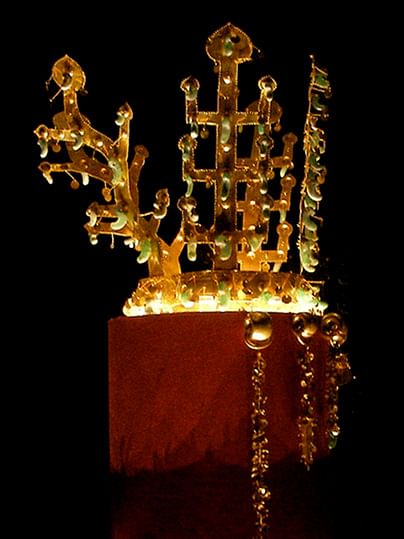
Queen Seondeok (Sondok) ruled the ancient kingdom of Silla from 632 to 647 CE and was the first female sovereign in ancient Korea. Silla was on the verge of dominating the whole of the Korean peninsula and Seondeok helped progress her kingdom towards this goal. Her reign was also distinguished by the increased integration of Buddhism, already the official state religion, and the construction of the famous Cheomseongdae, the oldest observatory in East Asia.
ACCESSION
Seondeok gained the throne because her father, king Jinpyeong (Chinpyong, r. 579-632 CE) who had reigned for 53 years, had no male heir. The fact that a queen could rule alone is testimony to the traditional high status of women in the royal lineage and illustrates the rigidity of the Silla social class system. The latter was based on the bone rank system which dictated all manner of privileges and obligations based on one's birth and bloodline. The highest social level was the sacred bone class which was only held by members of the royal house of Kim. When Jinpyeong died there were no living males of sacred bone rank and so one of two things had to happen: either the whole social class system had to be restructured or a queen was permitted to rule. The latter choice was taken, as it was again for the same reasons for Seondeok's successor.
Seondeok was her father's eldest daughter and her accession was recognised by the Tang Dynasty in 635 CE. In such historical records as the 12th-century CE Samguk sagi ('History of the Three Kingdoms'), she is referred to as wang (king) like her male predecessors. Seondeok was the kingdom's 27th ruler and inherited a prospering state with Silla, in the south-east of the Korean peninsula on the verge of conquering her long-time rivals of the Three Kingdoms period - Baekje ( Paekche ) to the west and Goguryeo ( Koguryo ) to the north. According to the Samguk sagi, one of the first acts of Seondeok as queen was to establish aid for poor commoners in the countryside.
UNDER SEONDEOK'S REIGN, SILLA SAW A FLOURISHING OF THE ARTS & SCIENCES, THE STATE BECAME MORE CENTRALISED & BUDDHISM WAS FURTHER ENCOURAGED.
THE TWO KIMS
Seondeok benefitted from having at her disposal the talents of the famous general Kim Yushin (595-673) and her nephew, the gifted diplomat Kim Chunchu (d. 661 CE). Chunchu was sent on a diplomatic mission to King Pojang of Goguryeo in 641 CE for help against an ever-more aggressive Baekje. The Goguryeo king, though, would only help if Silla gave up some of the territory they had previously taken from his kingdom. Seondeok refused, and so Chunchu was imprisoned. The queen then dispatched a 10,000-man army led by Kim Yushin to rescue Chunchu and rebuke Pojang for his impudence. When the Goguryeo monarch discovered an army was on its way he promptly released his captive. Both Kims would go on to greatly help Silla unify Korea and so win the legendary status they still enjoy in Korea today.
RELATIONS WITH TANG CHINA
Seondeok's immediate neighbours were still powerful and they continued to harass Silla (especially Baekje) to the extent that in 643 CE the queen sent a diplomatic embassy to China to persuade them to help meet this threat. The Chinese Tang Dynasty (618-907 CE) saw an opportunity to play these troublesome southern kingdoms against each other for their own benefit and so were happy to create an alliance with one of them so as to better deal with the remaining two.
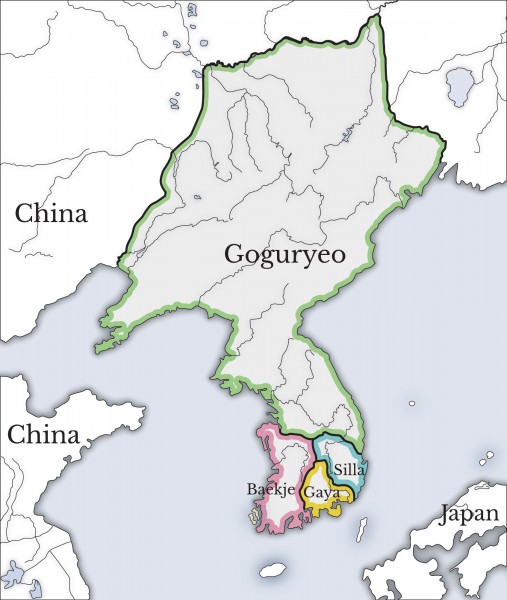
Three Kingdoms of Korea
Silla and China had long been trading partners and cultural exchange had seen the adoption of Tang court customs and Silla students and scholars being sent to China for study. Queen Seondeok strengthened these ties still further, but the Tangs would not give aid for nothing. Despite the emperor Taizong generously offering an army and even several thousand uniforms and Tang army banners so that Silla soldiers could better intimidate their enemies, there was one catch. The queen would have to stand down and allow a Chinese prince to rule Silla with the Tang emperor's justification for this necessity being his belief that a female ruler was emboldening Silla's enemies. Naturally, Seondeok diplomatically refused this condition but managed to gain Tang military assistance anyway, and the two states formed a joint army to quash Baekje and Goguryeo. However, the plan of action was unsuccessful, and they were soundly beaten by a Goguryeo force led by the celebrated general Yang Manchun in 644 CE. Three more times Tang armies were defeated over the following decade, and Silla would have to wait until 660 CE when another joint Tang-Silla force, this time considerably bigger than previous invasions, was formed and Baekje (660 CE) and Goguryeo (668 CE) were finally crushed.
A THRIVING KINGDOM
At home Seondeok's domestic policies were more successful than her foreign policy, and Silla saw a flourishing of the arts and sciences. The state became more centralised, and Buddhism was further encouraged, especially as it enhanced the aura of power enjoyed by Silla's ruling class and endorsed the monarch as an incarnation of the Buddha. No surprise then, that the queen also oversaw an extensive rebuilding programme, especially of Buddhist temples. Unfortunately, temples were largely made of wood and so have not survived, but some of their stone pagodas still stand. Schools were another area of investment by the queen during her reign.
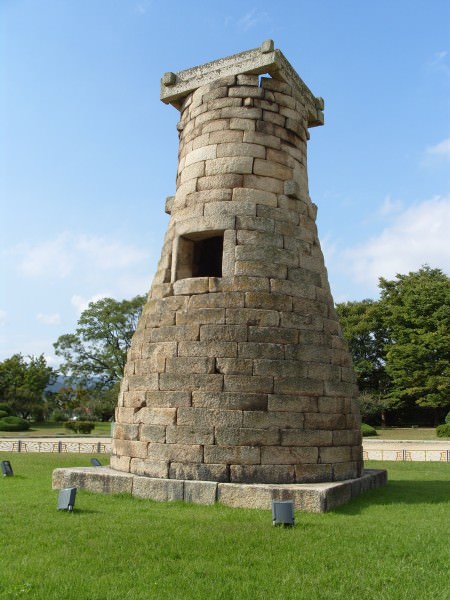
Cheomseongdae Observatory, Gyeongju
A notable surviving structure from Queen Seondeok's reign is the Cheomseongdae observatory at Gyeongju, the Silla capital.Nine metres tall, it acted like a sundial but also has a south-facing window which captures the sun's rays on the interior floor on each equinox. It was probably part of a larger complex dedicated to science and astronomy in particular. It is the oldest surviving observatory in East Asia. The tower has 27 brick courses representing Seondeok as the 27th Silla ruler. Some historians, without much support in terms of evidence or wider scholarly consensus, go further and suggest that the bottle shape of the structure is either itself a representation of Seondeok and the feminine form or a temple dedicated to her worship.
DEATH & SUCCESSORS
Seondeok died during a rebellion by disgruntled elements of the Silla aristocracy led by Kim Pidam, chairman of the government council of nobles. These aristocrats, who had the backing of the Tang dynasty, did not agree that a queen should sit on the throne of Silla, and believed that monarchs should now be chosen from members outside the sacred bone class, that is, themselves. The attempt to take her throne was quashed by the lower aristocracy who were led by the two Kims, but Queen Seondeok died, in any case, probably of illness.
Seondeok was succeeded by another queen, Chindok (r. 647-654 CE), who followed in her cousin's footsteps and helped Silla dominate the Korean peninsula. Once again there had been no Kim male of sacred bone rank, and after two queens, the bone rank system was modified with the highest sacred bone rank abolished and monarchs now chosen from the wider second level, the true bone rank. The next monarch after Chindok would be none other than Kim Chunchu, now calling himself King Muyeol, the first Silla monarch not to have been a member of the true bone rank and whose son would finally create the Unified Silla Kingdom ruling all of the Korean peninsula from 668 CE.
This article was made possible with generous support from the British Korean Society.
LICENSE:
Article based on information obtained from these sources:with permission from the Website Ancient History Encyclopedia
Content is available under License Creative Commons: Attribution-NonCommercial-ShareAlike 3.0 Unported. CC-BY-NC-SA License